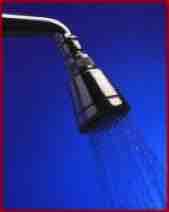Chlorine | Waternet
Chlorine and your Shower Part 1
New Scientist - 18.Sep.86
US News & World Report - 29.Jul.91
Bottom Line - Aug.87
Consumer Reports Books
American Journal of Public Health
Environmental Protection Agency
The NADER Report:
Troubled Waters on Tap
Science News - Vol.#130
New Scientist - 18.Sep.86
Taking long hot showers is a health risk, according to research presented last week in Anaheim, California,
at a meeting of the American Chemical Society. Showers--and to a lesser extent baths--lead to a greater exposure to toxic chemicals contained in water supplies than does drinking the water. The chemicals evaporate out of the water and are inhaled. they can also spread through the house and be inhaled by others. House holders can receive 6 to 100 times more of the chemical by breathing the air around showers and bath than they would by drinking the water.
(CHLORINE & YOUR SHOWER - Ian Anderson)
US News & World Report - 29.Jul.91
Studies indicate the suspect chemicals can also be inhaled and absorbed through the skin during showering and bathing.
Ironically, even the Chlorine widely used to disinfect water produces Carcinogenic traces. Though 7 out of 10 Americans drink chlorinated water, its safety over the long term is uncertain. Drinking chlorinated water may as much as double the risk of the Bladder Cancer, which strikes 40,000 people a year.
Is Your Water Safe - The Dangerous State of Your Water
Bottom Line - Aug.87
A long, hot shower can be dangerous.
The toxic chemicals are inhaled in high concentrations.
Dr John Andelman, PhD
Consumer Reports Books
On one hand, chlorination has freed civilisation from the constant dangers of waterborne epidemics.
On the other hand in the mid - 70s scientists discovered that chlorination could create carcinogens in water.
80% of the population drinks chlorinated water.
There was a higher incidence of cancer of the oesophagus, rectum, breast, and larynx and of Hodgkins Disease among those drinking chlorinated surface waters.
Volatile organics can evaporate from water in a shower or bath.
Conservative calculations indicate that inhalation exposures can be as significant as exposure from drinking the water, that is, one can be exposed to just as much by inhalation during a shower as by drinking 2 litres of water a day.
People who shower frequently could be exposed through ingestion, inhalation and/or dermal absorption.
IS YOUR WATER SAFE TO DRINK?
American Journal of Public Health
Skin absorption of contaminant has been underestimated and ingestion may not constitute the sole or even primary route of exposure.
Dr Halina Brown
Environmental Protection Agency
Showering is suspected as the primary cause of elevated levels of chloroform in nearly every home because of the chlorine in the water.
Dr Lance Wallace
The NADER Report - Troubled Waters on Tap
A Professor of Water Chemistry at the University of Pittsburgh claims that exposure to vaporised chemicals in the water supplies through showering, bathing, and inhalation is 100 times greater than through drinking the water.
As chlorine is added to kill pathogenic micro-organisms, the highly reactive chlorine combines with fatty acids and carbon fragments to form a variety of toxic compounds, which comprise about 30% of the chlorination by-products.
During the mid-1970s monitoring efforts began to identify widespread toxic contamination of the nation's drinking water supplies, epidemiological studies began to suggest a link between ingestion of toxic chemicals in the water and elevated cancer mortality risks. Since those studies were completed a variety of additional studies have strengthened the statistical connection between consumption of toxins in water and elevated cancer risks. Moreover, this basic concern has been heightened by other research discoveries.
Centre For Study of Responsive Law
Science News - Vol.#130
The National Academy of Sciences estimate that 200 to 1000 people die in the United States each year from cancers caused by ingesting the contaminants in water. The major health threat posed by these pollutants is far more likely to be from their inhalation as air pollutants. The reason that emissions are high is that because water droplets dispersed by the shower head have a larger surface-too-value ratio than water streaming into the bath.
Janet Raloff

